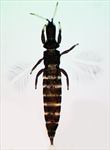
Female

Antenna
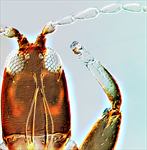
Head & fore leg

Pronotum

Pronotum
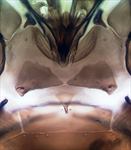
Prosternites
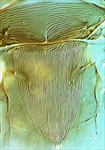
Meso & metanota
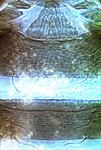
Pelta & tergites II–III
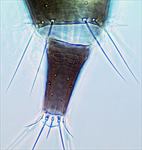
Female segments IX–X
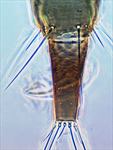
Male segments IX–X

Fore wing
Both sexes fully winged. Body brown with purple internal pigment; legs brown, mid and hind tarsi light brown, fore tarsi and apical third of fore tibiae bright yellow; antennal segments III–IV clear yellow, V–VI yellow with apices variable shaded; major setae brown; fore wings pale, scarcely shaded at base. Antennae 8-segmented; segment III with no sense cones, IV with 4 sense cones, VIII short and broad at base. Head distinctly longer than wide; maxillary stylets retracted to eyes, close together medially; eyes not prolonged ventrally; postocular setae pointed, shorter than eye length. Pronotum with 4 pairs of weakly capitate major setae, midlateral setae not developed; prosternal basantra and ferna well developed, mesopresternum reduced to paired lateral triangles. Fore tarsus with small pointed tooth. Metanotum closely striate medially. Fore wing constricted medially, without duplicated cilia. Tergite IX setae S1 finely acute, longer than tube.
Male similar to female, but fore tarsal tooth larger; tergite IX setae S2 short and stout; sternite VIII with no pore plate; pseudovirga of aedeagus slender.
The genus Leptothrips is related to Haplothrips, but the metanotal sculpture is closely striate not reticulate, and larvae and adults usually have extensive purple internal pigment. Currently, 30 species are listed under Leptothrips, all from the Americas. Johansen (1987) described 22 new species in the genus, with 11 Leptothrips recorded from California. However, Mound & O'Donnell (2017) placed nine species into synonymy and recognised only 15 Leptothrips species from North America of which nine are reported from California. Amongst these nine, purpuratus is one of three species in which females have a small tooth on the inner margin of the fore tarsus; it differs from distalis in lacking duplicated cilia on the fore wings, and from fasciculatus in lacking a sense cone on the third antennal segment, and in lacking paired mid-lateral setae on the pronotum.
Presumably predatory on other arthropods on desert shrubs, and adults have been taken particularly from Atriplex [Chenopodiaceae].
Recorded from Arizona, California, Texas and New Mexico.
PHLAEOTHRIPIDAE, PHLAEOTHRIPINAE
Leptothrips pupuratus (Hood)
Haplothrips pupuratus Hood, 1925: 101
Johansen RM (1987) El genero Leptothrips Hood, 1909 (Thysanoptera: Phlaeothripidae) en el continente Americano: su sistematica, filogenia, biogeografia, biologia, conducta y ecologia. Monografias del Instituto de Biologia. Universidad Nacional de Mexico 3: 1–246.
Mound LA & O’Donnell CA (2017) Predation, phytophagy and character state confusion among North American species of the genus Leptothrips (Thysanoptera: Phlaeothripinae). Zootaxa 4294 (3): 301-315.